Menu
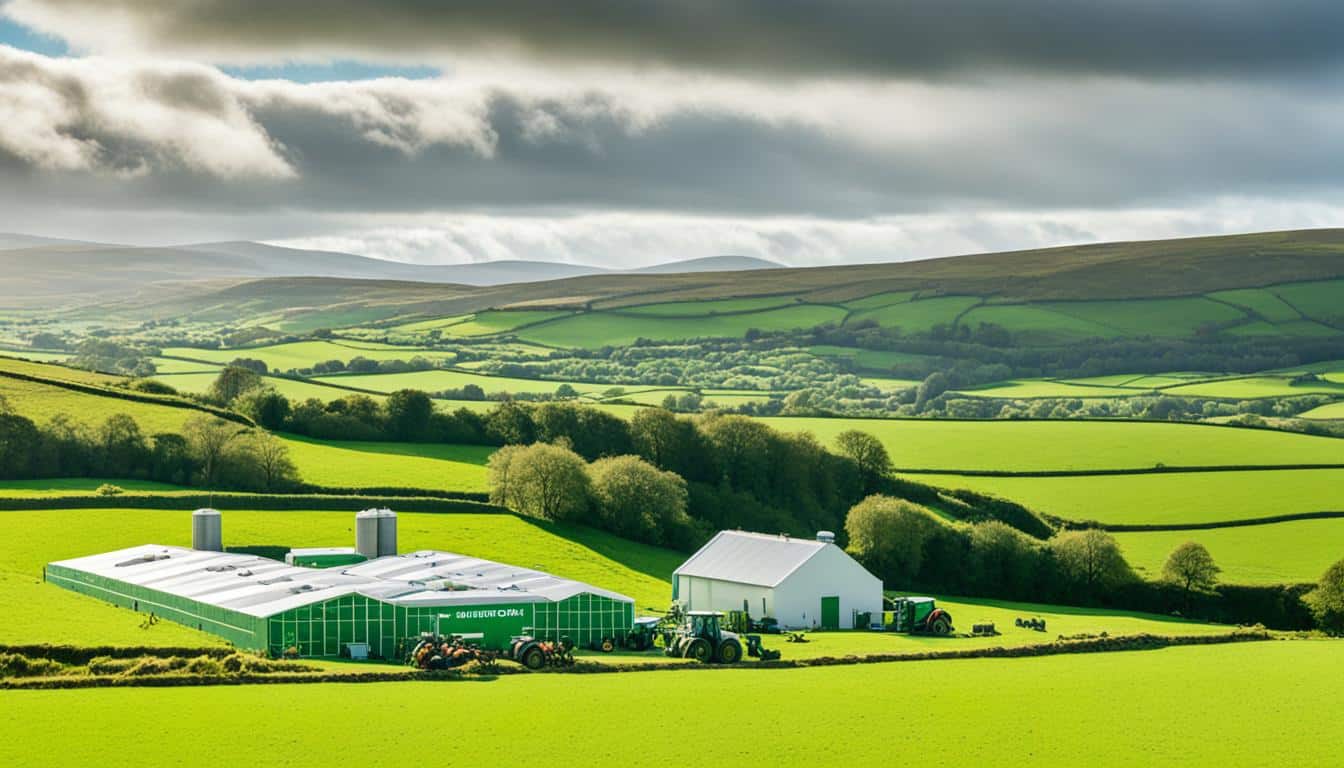
Did you know the EPA watches over 4,810 water bodies in Ireland? These include rivers, lakes, and coastal areas. It’s key to keep Ireland’s water clean, as about 60% of these sites are regularly checked. The Irish Environmental Protection Agency (EPA) farming schemes help farms follow the rules. This supports eco-friendly farming.
The Irish EPA does more than watch over water. It makes rules, does science, and works with others. Its big job includes keeping water clean from farming’s effects like nutrient leaks. Since farming can harm water quality, the EPA looks at lots of sites and helps the government with advice. It also makes sure farms use eco-friendly methods.
In 1993, the Irish EPA was formed, marking a significant step in how Ireland dealt with environmental issues. Before its creation, local authorities had to weigh up the need for development against protecting the environment. This often caused problems. The EPA was set up to boost trust in the country’s environmental protection efforts. It manages laws regarding the environment across Ireland to make sure they are followed.
Local authorities used to handle what the EPA does now. But in the early ’90s, this changed. The EPA took over, bringing a more focused and fair approach to keeping the environment safe. Its main job is to make sure everyone follows the environmental laws. It has also grown to take on new challenges as laws and the environment itself evolve.
The EPA works on many environmental issues. It’s especially focused on controlling pollutants and making sure water stays clean. It also aims to use the land in a way that doesn’t harm the environment. This work is key for the country’s farming, which can affect water by adding too many nutrients. By watching closely and acting early, the EPA tries to limit such problems.
The EPA is all about handling old and new environmental concerns in a way that keeps Ireland’s ecosystems healthy. It sticks to complex rules to guide how environmental care should be done. This process helps everyone, from local groups to farmers, work together better to protect the environment.
The Environmental Protection Agency (EPA) is vital for checking water quality, especially around Ireland’s farms. They look into the safety of both surface and underground water. This is key for farming and keeping the environment healthy. Knowing how the EPA checks water helps farms use water wisely.
The EPA checks over 60% of Ireland’s water areas regularly. This includes thousands of rivers, lakes, and coastal waters. They look at the health of the water for animals and plants, as well as the amount of certain substances in it. How often they check can be from three to twelve times a year for some things, and every three years for others.
Half of Ireland’s water is doing well, but the rest needs to improve. Farming is a big reason some water isn’t clean enough, because of things like nutrient pollution. This is why monitoring farms and their water use is so important.
The EPA’s water checks help farms understand how their actions affect water quality. They show that the levels of certain nutrients are key signs for water health. For example, nitrate levels had been improving but rose again recently. Phosphorus, however, is still too high in many rivers. It is making the water not as clean as it should be.
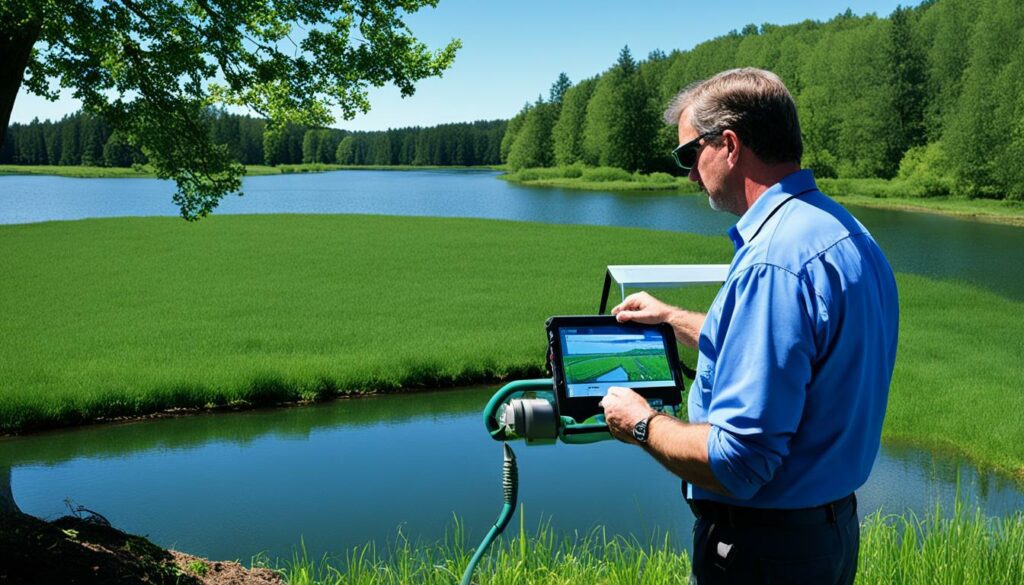
These insights lead farms to use better ways to manage their water. By following the EPA’s advice, farmers can keep the environment in balance. They should band together with plans like the Nitrates Action Programme. This way, water quality all over Ireland can get better.
Below is a close look at the water bodies and how they are doing:
| Type of Water Body | Monitored Water Bodies | Total Number of Water Bodies |
|---|---|---|
| Rivers | 2,429 | 3,200 |
| Lakes | 224 | 800 |
| Transitional Waters | 80 | 200 |
| Coastal Waters | 45 | 110 |
| Groundwater | 121 | 500 |
The EPA works hard to keep the environment safe. It has the power to give out licenses and permits for farming. These laws, like the Waste Management Act, help reduce the bad effects farming has on the environment.
Getting a permit for farming is crucial. It makes sure farming practices meet strict environmental rules. For example, permits control how much fertiliser and pesticides farms can use. They also govern how waste is disposed of.
By giving out these permits, the EPA helps protect the water and air quality. It also lowers the impact on our planet’s climate.
The EPA also checks farms regularly. This helps see if they’re following the rules to protect the environment. If a farm isn’t, they offer advice to get better.
If a farm still doesn’t follow the rules, the EPA takes action. This ensures everyone does their part to look after the environment.
The EPA is strong on inspecting farms and making sure they stick to the rules. Their approach combines checking up on farms with offering them help and advice. This way, they support farms while making sure they do their part in protecting the environment.
| Function | Description | Impact on Agriculture |
|---|---|---|
| Licensing and Permitting | Regulates use of substances and waste management in farming | Promotes sustainable and environmentally-friendly practices |
| Inspections and Enforcement | Annual audits and checks for compliance | Ensures adherence to environmental laws, reducing harmful practices |
| Legislative Framework | Waste Management Act, Water Services Act | Provides legal basis for enforcement and regulation |
It’s vital to have a clear guide for sustainable farming to protect our environment. The EPA’s guidelines are key for better farming across the board. For example, one key guideline is about using low-emission slurry spreaders. This helps cut down on harmful gas like ammonia, meeting high environmental farming standards.
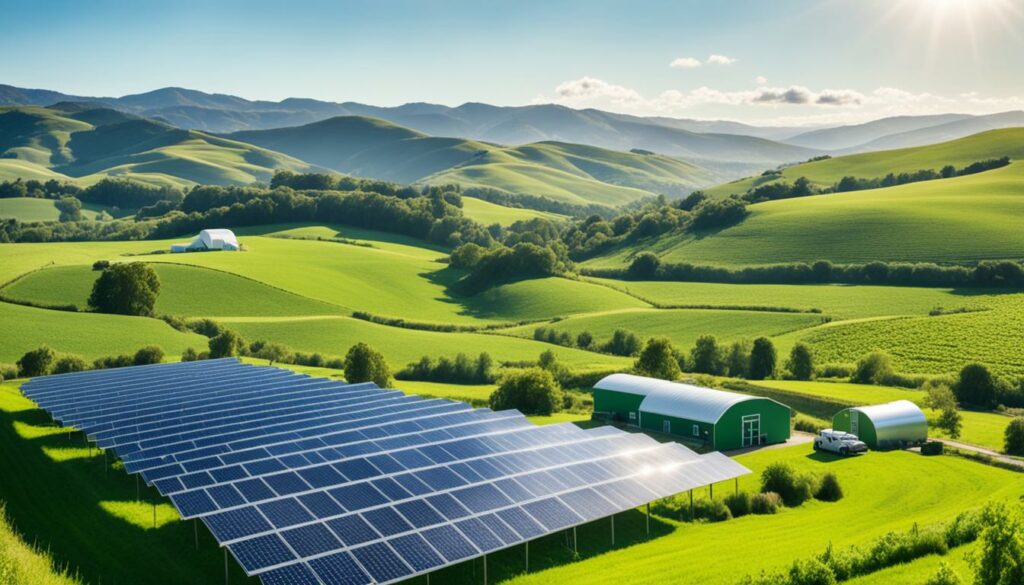
They also highlight the use of “stabilised urea” fertilisers to lessen the need for nitrogen fertilisers. This change led to a 14% drop in nitrogen use since 2021. This supports the EPA’s efforts to lower greenhouse gas emissions. It’s crucial since over 62% of agricultural emissions come from enteric fermentation, and almost 19% from agricultural soils. By using these new methods, we can cut these emissions in a sustainable way.
The EPA isn’t just about following rules but about making farming better and more efficient. Even with a slight increase in dairy production in 2022, emissions from this sector went down by 0.3%. This shows how following the EPA’s advice can help both the farm and the planet. It shows how increasing farm work can go hand in hand with protecting the environment.
In a bigger picture, farming in Europe still puts a lot of strain on our water systems. Making farming sustainable means looking at everything from how farms work to what shoppers want and the laws that govern it all. If we stick to the EPA’s strategies, we might lower emissions by 20% from 2021 to 2030. This is a big goal, but it’s possible with everyone playing their part.
Finally, the EPA also stresses teamwork for farming that’s both effective and green. They encourage everyone to get involved, from government bodies to individual farmers. By working on the goals of the European Green Deal together, we can build a healthier future for farming, for us, and for our planet.
| Source of Emissions | % of Total Agricultural Emissions (2022) |
|---|---|
| Enteric Fermentation | 62.44% |
| Agricultural Soils | 18.75% |
| Manure Management | 11.66% |
| Fuel Combustion in Agriculture/Forestry/Fishing | 3.94% |
| Liming Activities | 2.67% |
| Urea Application | 0.54% |
The EPA’s regulations greatly affect farming’s future. In 2022, agriculture accounted for a big 38.5% of Ireland’s greenhouse gas emissions. Although emissions dropped by 0.3% in 2022, they jumped by 15.8% in the last 10 years. This shows the urgent need for strict EPA rules to protect our planet and help farms thrive sustainably.
There has been good progress in making agriculture more sustainable. For instance, nitrogen fertiliser use dropped by 14.0% since 2021. Dairy cow numbers increased by 0.9% in 2022, boosting milk production by 0.7%. But, emissions from livestock’s digestion (enteric fermentation) still make up a huge 62.44% of the total. This highlights the ongoing difficulty in cutting down on farming’s greenhouse gases.
EPA regulations push for eco-friendlier farming methods. These actions have helped control harmful runoff, protecting Ireland’s waters. A decrease in total farming emissions by 4% is expected by 2030, with possible further reductions under more measures. This shows the EPA’s efforts bring real, positive change for the future.
Given this information, following the EPA’s rules is key to a sustainable farming future. Steps like using low-emission slurry spreading and less nitrogen fertiliser are crucial. These efforts not only protect the environment but also help Ireland’s agriculture future. The data proves the value of these rules in preserving our environment and supporting a healthy future for farming in Ireland.
| Parameter | 2022 Data | Change Over Decade (2012-2022) |
|---|---|---|
| Greenhouse Gas Emissions | 38.5% | +15.8% |
| Nitrogen Fertiliser Use | -14.0% | – |
| Dairy Cow Numbers | +0.9% | +42.5% |
| Milk Production | +0.7% | +68.6% |
| Sheep Numbers | – | +14.7% |
| Pigs | – | +4.6% |
| Poultry | – | +20.4% |
Putting environmental rules into action in farming isn’t easy. Farmers try to keep up with production while meeting strict EPA standards. They face common problems when it comes to following these rules. In this section, we’ll look at the common farming compliance issues and how farmers push back.
In Ireland, farming makes up a big part of the pollution. It caused 38.5% of the country’s greenhouse gases in 2022. To stick to EPA rules, farmers must cut down on enteric fermentation, which causes most of these gases. They must also manage manure better, which is another big polluter. But, these changes often need a lot of money and changes in how they work.
| Issue | Impact | Compliance Challenge |
|---|---|---|
| High Greenhouse Gas Emissions | 38.5% of total emissions | Costly mitigation practices |
| Nitrogen Fertiliser Use | Decreased by 14% since 2021 | Expensive alternatives needed |
| Increased Dairy Production | 42.5% rise in dairy cow numbers (2012-2022) | Modification of long-standing practices |
| Water Quality Issues | 47% of river sites have unsatisfactory nitrate levels | Implementing sustainable water management practices |
Farmers often resist following EPA rules. They worry about the costs of new ways and losing the methods they’re used to. For example, they’re slow to change when told to use less nitrogen fertiliser. This change is part of the AgClimatise plan but means spending more and finding new ways to farm.

To tackle these challenges, education and working together are key. The EPA says we need plans for every farm that think about the environment and how the farm works. By explaining and helping, the EPA and farm groups can cut pollution and make the water cleaner. This way, they support farmers without making them feel left out.
Over the years, EPA regulations have greatly improved Irish farming. They have made a big difference in making the water cleaner. This is by controlling the amount of nutrients like nitrogen and phosphorus that enter the water. Such actions reduce the growth of harmful algae and improve water quality.
Not just that, it has also improved Ireland’s agriculture internationally. The tough rules set by the EPA have made the environment healthier and agriculture respected worldwide.
The EPA has also taken steps to lower greenhouse gas emissions. These steps are in line with the wider European efforts, like the European Green Deal. Together with the ‘Fit for 55’ goals, there’s been a drop in harmful emissions from farm activities. This is a vital step in making Irish farming more eco-friendly.
Part of improving Irish farming is to export more agri-food products. The aim is to grow exports from €14.5 billion in 2019 to €19 billion by 2025. Also, to create 23,000 new jobs. To reach these goals, the country is focusing on sustainable ways to farm. This includes using fertilisers that are better for the environment and farming methods that reduce pollution.
| Statistic | Value |
|---|---|
| Agri-food exports in 2019 | €14.5 billion |
| Percentage of total exports | 10% |
| Employment in the agri-food sector 2019 | 173,000 jobs |
| 2025 Agri-food export target | €19 billion |
| Targeted job creation by 2025 | 23,000 jobs |
| Land used for agriculture | 67.6% (4.76 million hectares) |
The changes have not only helped the environment. They have also made life better in rural areas. Here, many farms have been improving how they work, especially in beef production. Half of Ireland’s farms, mainly in the Border, Midland, and Western regions, have become more efficient and are following environmental rules better thanks to the EPA.
The Environmental Protection Agency (EPA) and agricultural groups in Ireland work together for greener farming. They join forces to tackle big environment issues. This helps make agriculture more sustainable.
The EPA teams up with Teagasc on important work. Teagasc collaboration combines science with practical farm tips. Teagasc is critical for research, advice, and training in the farm field in Ireland. With the EPA, it finds ways for farming to use the land well without harming the environment.
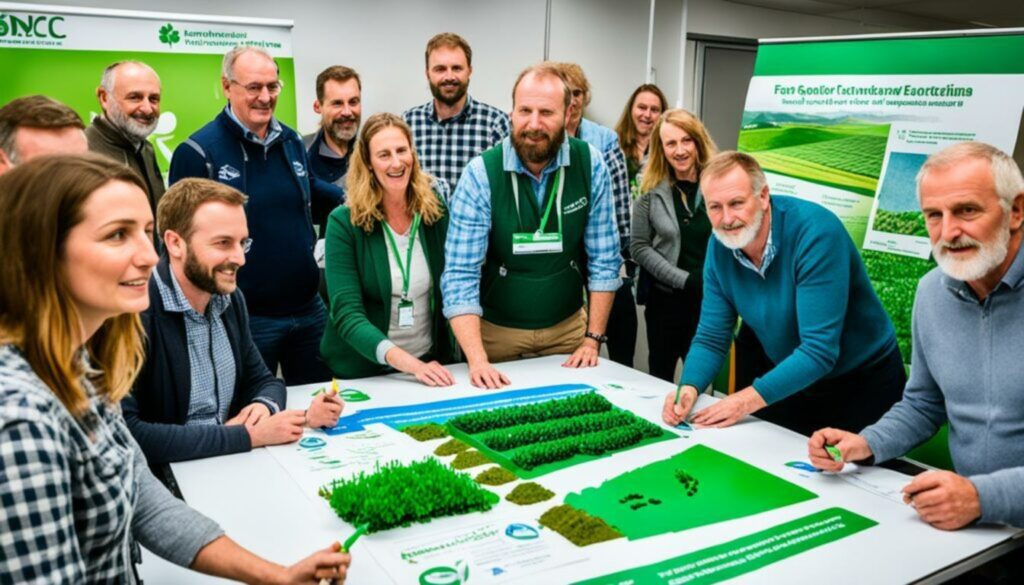
This teamwork doesn’t just help the environment now. It also supports big farm goals for the future, like boosting food exports and creating jobs. Together, the EPA and Teagasc encourage new, smarter ways to farm. They focus on keeping the soil and the nutrients in check.
The EPA also joins hands with local groups on the Local Authority Waters Programme. This work targets local water challenges, looking at what each region needs.
Often, 60% of water bodies in Ireland are checked for quality. Work aims to keep water clean with special plans for different areas. For example, farms in places with slow-draining soil get help tailored to their needs, like in Limerick and Monaghan.
Through EPA agricultural partnerships, farmers get involved in caring for the environment. This makes them feel more connected and responsible. Working with local groups, the EPA guides farmers on how to farm in ways that protect Ireland’s water.
| Collaborative Entity | Key Focus Area | Impact |
|---|---|---|
| Teagasc | Research and implementation of sustainable farming practices | Enhanced nutrient management; improved soil health |
| Local Authority Waters Programme | Water quality monitoring and local water management | Region-specific solutions; reduced agricultural runoff |
The agriculture sector in Ireland is a big player in producing greenhouse gases. The main culprits are methane and nitrous oxide. The EPA is key in controlling these emissions. They gather data from 1990 to now, looking ahead to 2030. This info helps make plans to lower these gases.
In 2022, farming created 38.5% of Ireland’s greenhouse gases. Their emissions dropped by 0.3% that year but had gone up by 15.8% in the past decade. The biggest cause is enteric fermentation, making up 62.44% of gases. Dairy farming saw more cows and milk, leading to increased emissions.
The EPA pushes for using the latest tech to cut down on these gases. Special fertilisers can reduce the gases coming from the ground. They’ve been tested and show promise. This proves new tech can help lower emissions from farming.
They also encourage using new ways to spread cow manure. By doing this, a 4% cut in gases from farming might happen by 2030. With even more efforts, a 20% drop could be reached. This shows there’s hope to make a real difference.
Using new tech is vital to fight these emissions. The EPA is at the forefront, helping Ireland reach its green goals. They support eco-friendly farming to keep our planet healthy.
The EPA checks how farm activities affect the environment to push for eco-friendly farming. They collect vital info to help make better policies and support farming that’s kind to nature.
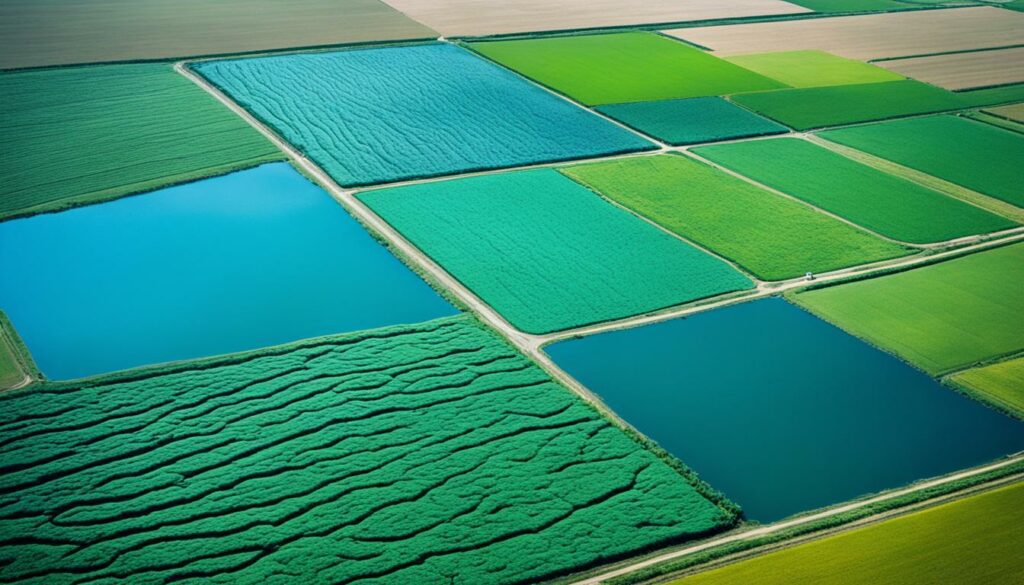
The things farms do can greatly impact nature. The EPA looks at many farm practices, like using fertiliser and managing animals. They’re especially concerned about gases like methane from cows and nitrous oxide from fertilisers.
In 2022, farming in Ireland made up nearly 40% of all the country’s greenhouse gas emissions. This was mostly from gases like methane and nitrous oxide. It shows why we need to keep an eye on farm activities to protect our planet.
The EPA also tracks how farm practices change over time. For example, the number of dairy cows went up slightly in 2022 with more milk produced. But, looking back over the past ten years, the increase in cows and milk is significant. This shows why ongoing monitoring is crucial to address the environmental impact effectively.
How often the EPA checks farm practices depends on their potential environmental harm. Some things, like nutrients running off into water, need checking several times a year. But, less urgent issues might get reviewed only once every three years. This approach helps them keep up with the latest info and make necessary changes as soon as they’re needed.
In 2022, Ireland’s farm emissions dropped by a bit. But, over ten years, they went up by nearly 16%. Emissions today are over 16% higher than they were in 1990. This shows the vital role of always watching farm impacts. If we keep doing what we are, farm emissions could drop slightly by 2030. But, if we try even harder, we could see a big drop in emissions by then.
The Environmental Protection Agency (EPA) looks into Irish water bodies, mainly checking farm pollution effects. They find issues needing actions to keep water quality high. Their work gives us a vital look at Ireland’s water and the problems it faces.
Farming greatly affects water quality in Ireland, affecting over 1,000 sites. Farm runoffs, with nitrogen and phosphorus, cause a lot of harm. This leads to eutrophication, which upsets water life by creating too much algae. This, in turn, lowers oxygen, impacting plants and animals.
Nutrient levels, including nitrate, have been on a rollercoaster. They spiked in 2018-2019 but only slightly improved since then.
Out of 4,810 water sites in Ireland, 60% are under watch. The study found that 54% of surface water systems are okay. But 46% are not, with many rivers having too much nitrate. This is really bad for the water’s health and cleanliness.
| Water Body Category | Total Water Bodies | Monitored | Percentage in Good Ecological Status |
|---|---|---|---|
| Groundwater | 500 | 121 | 54% |
| Rivers | 3200 | 2429 | 54% |
| Lakes | 800 | 224 | 54% |
| Transitional Waters | 200 | 80 | 54% |
| Coastal Waters | 110 | 45 | 54% |
Farm pollution problem is widespread, especially high phosphorus levels. Many rivers and lakes suffer. In 2022, the EPA found too much phosphorus in 28% of rivers and 36% of lakes. This calls for better farming methods quickly.
More care and planning can help reduce the water quality issues caused by farming. By tackling these problems, Ireland can meet its water protection goals. These aims are outlined in major directives like the Water Framework Directive.
The EPA’s work in farming follows a big set of laws for environmental protection. These laws are crucial. They’ve helped the EPA decide how to limit the harm farming can do to nature.

Some key laws pave the way for this system. The Environmental Protection Agency Act, 1992 was the first step. It set up EPA in 1993. It showed how EPA could make rules. Also crucial is the Waste Management Act, 1996. It lets the EPA watch over how waste is managed, touching on farming’s waste work.
The Water Services Act, 2007 focused on water. It made the EPA a major player in keeping water clean, which is big for farms. The Water Framework Directive Regulations tie our rules to EU water goals. Between 2018-2021, plans were made to better control how water is used.
As issues change, laws must keep up. The Waste Management Act got a refresh to deal better with farm waste. This keeps our farming methods up to date.
The EPA also gets better at making sure rules are followed. This helps key laws stay strong. New steps protect the planet and support smarter farming.
| Key Legislation | Focus Area | Significance |
|---|---|---|
| Environmental Protection Agency Act, 1992 | Establishment of the EPA | Foundation of EPA’s authority |
| Waste Management Act, 1996 | Waste regulation | Expanded EPA’s regulatory reach |
| Water Services Act, 2007 | Water quality supervision | Integral for water-related farming impacts |
By updating laws, the EPA stays focused on keeping our environment safe. These laws help farms do better for nature.
Following the Irish EPA’s rules is crucial for farmers. By sticking to these guidelines, they meet high environmental standards. This not only benefits the environment but also the farming community’s future. Importantly, it keeps farms sustainable.
Sticking to the EPA’s rules is really important. With nearly 40% of Ireland’s greenhouse gases coming from farms, it’s key to reduce this. Though emissions dropped slightly last year, overall they’re up by 15.8% in the last ten years. Compliance aims to reverse this trend, helping the environment in the long run.
Adhering to EPA standards has many upsides for farmers. Using less nitrogen fertiliser reduces costs and benefits the soil. It also boosts a farm’s image and makes it eligible for environmental subsidies. This is especially key for lowering greenhouse gases from cows and managing manure better.
By adopting the EPA’s green strategies, farmers can maintain their farm’s growth. This also contributes to a cleaner local environment. Predictions show emissions will fall under EPA guidance. This means compliance is vital for achieving these environmental goals and securing a strong future for farming.
The Irish EPA checks that farms follow the rules to protect the environment. They do this by giving out licences, inspecting farms, and making sure everyone sticks to their guidelines.
The Irish EPA started in 1993. It was created to bring together all environmental tasks under one group. This made sure the country followed its environmental laws properly.
The main goals of the Irish EPA are to control pollutants and check how land is used. They also look at water quality and share scientific advice. Their aim is to help take good care of the environment.
The EPA tests more than 4,800 water areas in Ireland. They look for certain nutrients from farms like nitrogen and phosphorus. This shows if water is clean or not.
The EPA’s water checks have led to better farming ways. Farmers are now using methods that are kinder to the environment. This makes their farms more sustainable.
The EPA oversees farming with licences and audits. They also make sure farms are following laws like the Water Services Act. Their role is to enforce these environmental rules.
They give out detailed rules for farms to be more eco-friendly. These include spreading slurry in a way that makes less pollution. They also recommend certain kinds of fertilisers. These guidelines help farms have a smaller impact on the environment.
EPA’s rules push for eco-friendlier farming. This means using less nitrogen fertiliser. It also means doing things that keep Ireland’s water in good shape. By following these rules, farms become more sustainable.
Challenges include extra labour and costs to be more eco-friendly. Also, changing old farming ways can be hard. But it’s necessary to protect the environment.
There have been great results in making water cleaner and reducing pollution in the air. Also, farms are now using methods that are better for the environment. All this shows that EPA’s work is making a positive difference.
The EPA works closely with groups like Teagasc and local councils. Together, they work on projects to keep water clean and improve farming methods.
The EPA looks at and works to lower the greenhouse gases that farms produce. They support using technologies that cut down pollution. This helps in fighting climate change.
The EPA keeps an eye on fertiliser use and how animals are looked after. They check these things anywhere from several times a year to once every three years. This depends on what they are looking at.
The EPA’s checks show that certain farm nutrients in water, like phosphorus and nitrogen, harm its quality. This can lead to water problems like eutrophication.
Laws like the Waste Management Act and the Water Services Act give the EPA their power. These laws are updated as the environmental challenges change. They guide the EPA’s work on farms and in other areas.
Following EPA rules is vital for farmers. It helps keep the environment safe and clean. It also improves their farm’s reputation and lets them access support for sustainable farm practices.